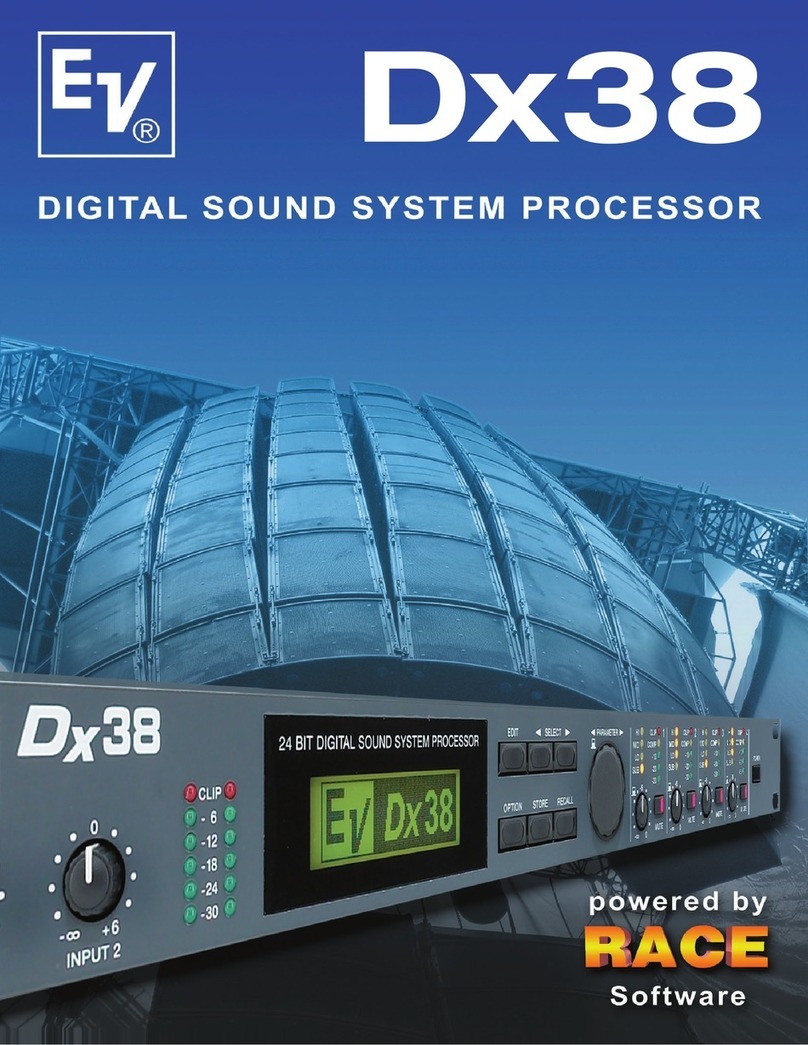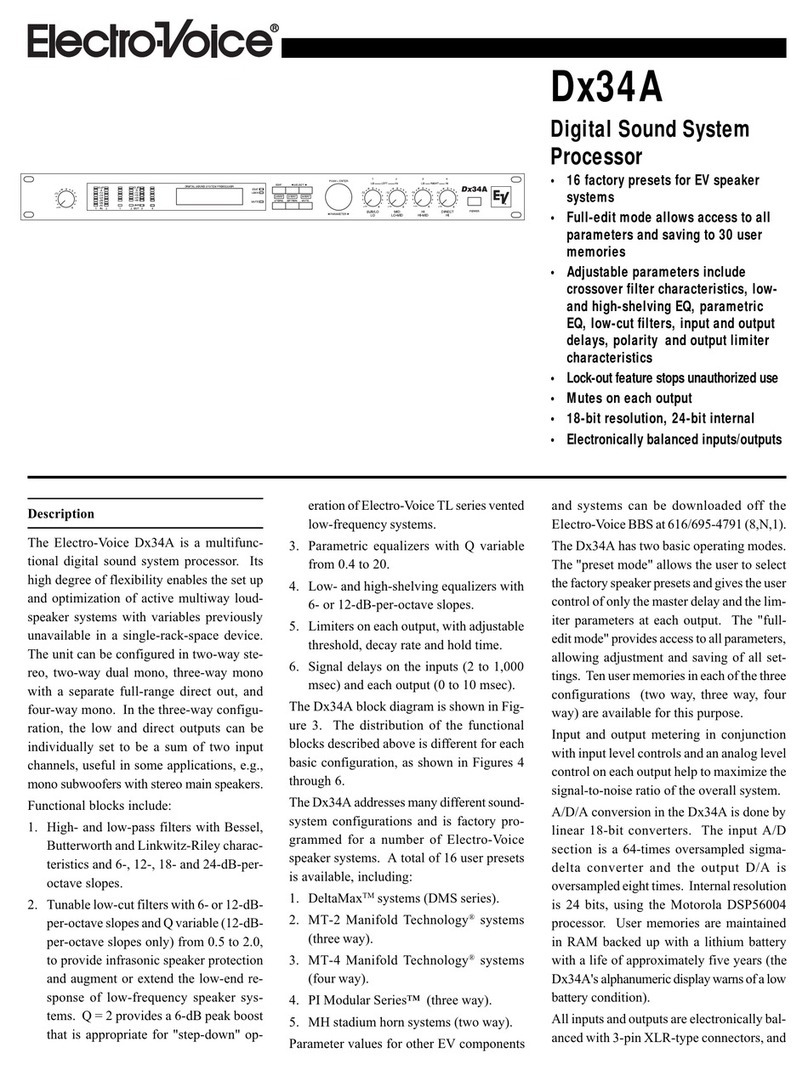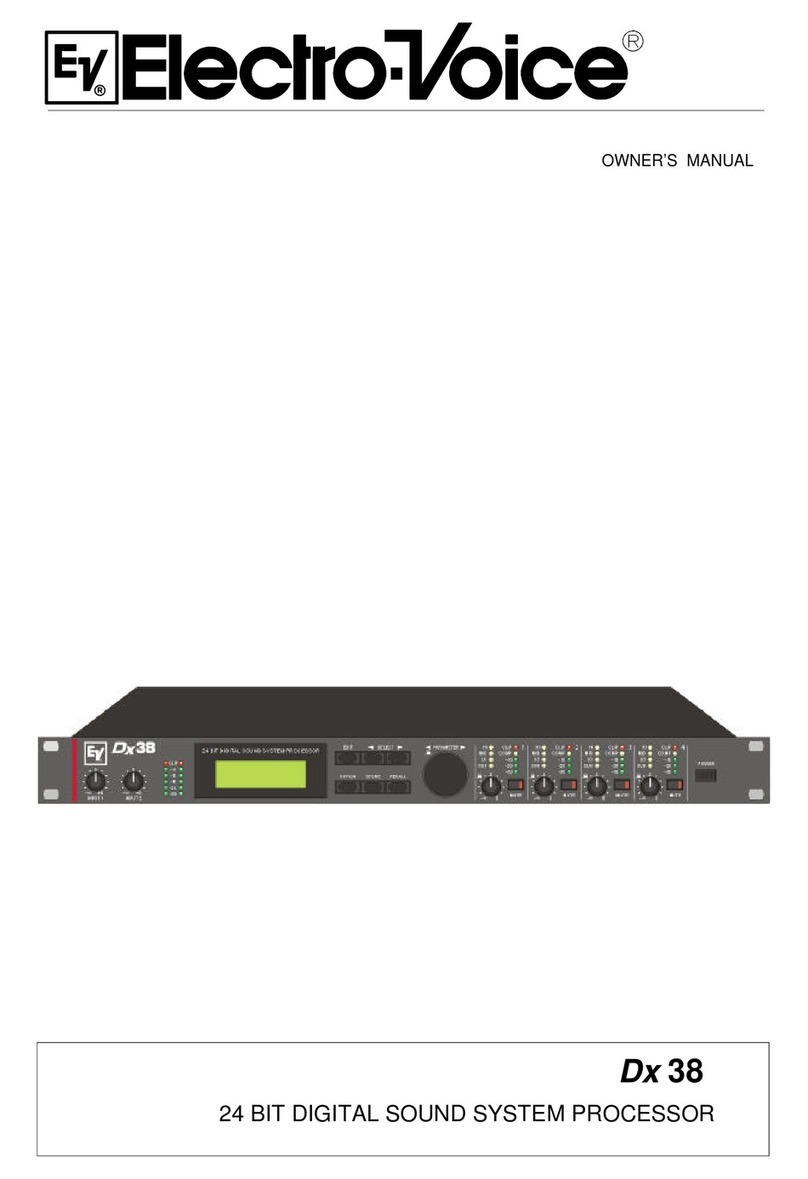BESCHREIBUNG
Mit 48 Bit Filteralgorithmen, 24 Bit AD/DA Wandlern und einem Dyna-
mikbereich von 115 dB setzt der Dx 38 neue Maßstäbe für digitale
Lautsprecher Kontroller und Prozessoren. Der Dx 38 ist ein universell
einsetzbarer Digitaler Sound System Processor mit 2 Eingängen und
4 Ausgängen, sowie zusätzlich einer internen Summe der Eingänge 1
und 2. Die Ausgänge können in einer Matrix auf einen beliebigen
Eingang oder die Eingangssumme geroutet werden. Es können Ste-
reo bzw. Dual 2-Weg-Systeme oder 3-Weg+Direct und 4-Weg Syste-
me, jeweils auch mit Mono Sub-Kanal, aber auch Fullrange Systeme
konfiguriert werden.
InallenBetriebsartenstehen Hoch- und Tiefpaß-Filter für die Frequen-
zweichen-Funktionen zur Verfügung. Die Auswahl umfaßt Linkwitz-
Riley, Butterworth und Bessel Filter mit wählbaren Flankensteilheiten
von 6, 12, 18 oder 24 dB/Okt. Eine große Anzahl weiterer Filter
ermöglicht eine äußerst flexible Frequenzgangskorrektur. In den Ein-
gängen finden Sie jeweils einen 5-Band Equalizer, dessen einzelne
Filtersektionen beliebig mit High- und Low-Pass, High- und Low-Shel-
ving oder parametrischen Peak-Dip-Filtern belegt werden können. In
den Ausgängen sind neben den Frequenzweichen-Filtern jeweils 4
weitere Filter enthalten, die ebenfalls als High- und Low-Pass Filter,
High- oder Low-Shelving-Filter, parametrische Peak-Dip-Filter, oder
Allpass-Filter programmiert werden können. Weitere Filtermöglichkei-
ten sind z. B. Hochpässe 2. Ordnung zur Realisierung von B-6 Align-
ments, oder spezielle LPN-Filter (Lowpass Notch / Tiefpaß-Sperrfilter)
zur Korrektur des Frequenz- und Phasengangs von Baßreflexboxen.
Zusätzlich ist jeder Kanal mit einem Delay, einem Polaritätswahlschal-
ter, einem programmierbaren Pegelsteller und einem digitalen Kom-
pressor / Limiter ausgestattet. In den Eingängen befinden sich
außerdem noch die Master-Delays.
Der Anwender hat die Wahl zwischen zwei Bedien-Modi: Im einfach-
sten Fall (No Edit Mode) brauchen nur die verwendeten Lautsprecher-
kombinationen aus der Liste der Factory Preset Programme aus-
gewählt werden. Das Gerät ist danach optimal auf die Audioanlage
eingestellt und sofort betriebsbereit. Im Full Edit Mode hingegen
besteht Zugriff auf sämtliche Parameter, so daß beliebige Einstellun-
gen programmiert und gespeichert werden können. Es stehen insge-
samt 80 Programmplätze - 50 für die Factory Presets, und weitere 30
für frei programmierbare User-Programme - zur Verfügung.
Die AD/DA-Wandlung im Dx 38 erfolgt mit linearen 24 Bit Wandlern,
wobeiessichin der AD-Sektion um gainrangingSigma-Delta-Wandler
mit128-fachemOversamplinghandelt. Im DA-Bereich wird mitSigma-
Delta Wandlern mit 128-fachem Oversampling gearbeitet. Die Signal-
verarbeitung erfolgt auf zwei 24 Bit Motorola Signalprozessoren.
DESCRIPTION
Providing 48-bit filter algorithms, 24-bit AD/DA conversion and a
dynamic range of 115 dB, the Dx 38 sets new standards for digital
loudspeaker controllers and processors. The Dx 38 is an universal
Digital Sound System Processor that provides 2 inputs and 4 outputs;
plus internal summing of the inputs 1 and 2. Via matrix it is possible to
assign the outputs to any input or to the sum of the inputs. It is further
possible to establish the following configurations: Stereo or Dual
2-Way systems, 3-Way + Direct and 4-Way systems, each with Mono
Sub-channel, but also full range systems.
High and low-pass filters are provided for the frequency crossover
functions in all operation modes. The selection includes Linkwitz-Ri-
ley,ButterworthandBesseltypefilterswithswitchableslopesbetween
6, 12, 18 and 24 dB/oct. A huge number of additional filters offers
extremely flexible correction of the frequency response. Each input
incorporatesa 5-band equalizer,allowing to assignhigh and low-pass,
high and low-shelving or parametric peak-dip filters to its individual
filter sections. Next to the frequency crossover filters, four additional
filters are employed in each output channel, which also can be set to
work as high or low-pass, high or low-shelving filters, parametric
peak-dip filters, or all-pass filters. Additional filtering is provided
through 2. order high-passes for the realization of B-6 alignment, or
special LPN-filters (Low-Pass Notch filters) for correcting the frequen-
cy and phase responses of optimally vented woofer cabinets. Each
channel additionally provides a delay, a polarity switch, a program-
mable level control and a digital compressor / limiter while the master
delays are located in the input channels.
The user can choose between two operation modes: the “No Edit
Mode”allows to simplyselect the requiredcombination of loudspeaker
systemsfromthefactorypresetprogramlist.Afterwards,the appliance
is optimally matched to the sound system and can be operated
instantly. The “Full Edit Mode” on the other hand offers access to all
parameters, allowing to freely program and store basically any setting.
A total number of 80 memory addresses - 50 preset and 30 freely
assignable user-programs - are available.
Technische Informationen
Architects and engineers
specifications
Dx 38
24 BIT DIGITAL SOUND
SYSTEM PROCESSOR
Weitere Merkmale sind:
- FLASH Speicher für Software und Preset Updates über
serielle Schnittstellen
- PC Bedien- und Konfigurationssoftware unter Windows 95 /
Windows 98
- MIDI-Schnittstelle standardäßig
- RS-232, RS-485 Schnittstellen oder Umschaltkontakte optional
- Grafik-Display mit 122 x 32 Dots, hintergrundbeleuchtet
- Ein- und Ausgänge elektronisch symmetrisch in XLR
- Trafosymmetrierung für die Eingänge optional
- Input / Output Pegelsteller, Output Mute Schalter, Kanal-
Funktionsanzeigen SUB, LO, MID, HI
- Input / Output Aussteueranzeigen, Kompressor- und Clip-LED’s

































